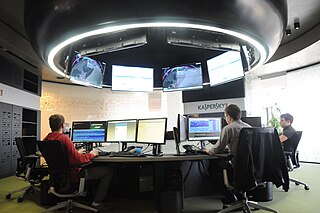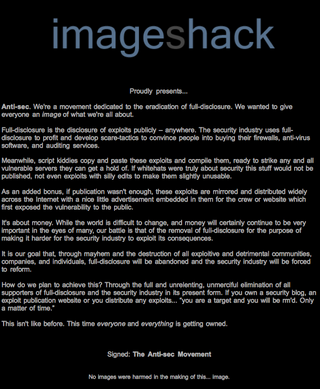Computer and network surveillance is the monitoring of computer activity and data stored locally on a computer or data being transferred over computer networks such as the Internet. This monitoring is often carried out covertly and may be completed by governments, corporations, criminal organizations, or individuals. It may or may not be legal and may or may not require authorization from a court or other independent government agencies. Computer and network surveillance programs are widespread today and almost all Internet traffic can be monitored.

Internet activism, hacktivism, or hactivism, is the use of computer-based techniques such as hacking as a form of civil disobedience to promote a political agenda or social change. With roots in hacker culture and hacker ethics, its ends are often related to free speech, human rights, or freedom of information movements.

This timeline of computer viruses and worms presents a chronological timeline of noteworthy computer viruses, computer worms, Trojan horses, similar malware, related research and events.

Cult of the Dead Cow, also known as cDc or cDc Communications, is a computer hacker and DIY media organization founded in 1984 in Lubbock, Texas. The group maintains a weblog on its site, also titled "[Cult of the Dead Cow]". New media are released first through the blog, which also features thoughts and opinions of the group's members.

The Bhabha Atomic Research Centre (BARC) is India's premier nuclear research facility, headquartered in Trombay, Mumbai, Maharashtra, India. It was founded by Homi Jehangir Bhabha as the Atomic Energy Establishment, Trombay (AEET) in January 1954 as a multidisciplinary research program essential for India's nuclear program. It operates under the Department of Atomic Energy (DAE), which is directly overseen by the Prime Minister of India.
globalHell was a group of hackers. The group disbanded in 1999 due to being prosecuted for computer intrusion. The combined losses were estimated to be ranged between $1.5m and $2.5m. They were one of the first hacking groups who gained notoriety for website defacements and breaches. The group was called a "cybergang" as it had many of the same characteristics of a gang, such as the organizational structure. They carried out some of the same activities as a gang, including trafficking in stolen credit card numbers.
The 1998 MTV Video Music Awards aired live on September 10, 1998, honoring the best music videos from June 17, 1997, to June 12, 1998. The show was hosted by Ben Stiller at Gibson Amphitheatre in Los Angeles.

Anonymous is a decentralized international activist and hacktivist collective and movement primarily known for its various cyberattacks against several governments, government institutions and government agencies, corporations and the Church of Scientology.

Kaspersky Lab is a Russian multinational cybersecurity and anti-virus provider headquartered in Moscow, Russia, and operated by a holding company in the United Kingdom. It was founded in 1997 by Eugene Kaspersky, Natalya Kaspersky and Alexey De-Monderik. Kaspersky Lab develops and sells antivirus, internet security, password management, endpoint security, and other cybersecurity products and services.

The Anti Security Movement is a movement opposed to the computer security industry. Antisec is against full disclosure of information relating to software vulnerabilities, exploits, exploitation techniques, hacking tools, attacking public outlets and distribution points of that information. The general thought behind this is that the computer security industry uses full disclosure to profit and develop scare-tactics to convince people into buying their firewalls, anti-virus software and auditing services.

Andrew Alan Escher Auernheimer, best known by his pseudonym weev, is an American computer hacker and professional Internet troll. Affiliated with the alt-right, he has been described as a neo-Nazi, white supremacist, and antisemitic conspiracy theorist. He has used many aliases when he has contacted the media, but most sources state that his real first name is Andrew.

LulzSec was a black hat computer hacking group that claimed responsibility for several high profile attacks, including the compromise of user accounts from PlayStation Network in 2011. The group also claimed responsibility for taking the CIA website offline. Some security professionals have commented that LulzSec has drawn attention to insecure systems and the dangers of password reuse. It has gained attention due to its high profile targets and the sarcastic messages it has posted in the aftermath of its attacks. One of the founders of LulzSec was computer security specialist Hector Monsegur, who used the online moniker Sabu. He later helped law enforcement track down other members of the organization as part of a plea deal. At least four associates of LulzSec were arrested in March 2012 as part of this investigation. Prior, British authorities had announced the arrests of two teenagers they alleged were LulzSec members, going by the pseudonyms T-flow and Topiary.

Operation Anti-Security, also referred to as Operation AntiSec or #AntiSec, is a series of hacking attacks performed by members of the hacking group LulzSec and Anonymous, and others inspired by the announcement of the operation. LulzSec performed the earliest attacks of the operation, with the first against the Serious Organised Crime Agency on 20 June 2011. Soon after, the group released information taken from the servers of the Arizona Department of Public Safety; Anonymous would later release information from the same agency two more times. An offshoot of the group calling themselves LulzSecBrazil launched attacks on numerous websites belonging to the Government of Brazil and the energy company Petrobras. LulzSec claimed to retire as a group, but on 18 July they reconvened to hack into the websites of British newspapers The Sun and The Times, posting a fake news story of the death of the publication's owner Rupert Murdoch.
Anonymous is a decentralized virtual community. They are commonly referred to as an internet-based collective of hacktivists whose goals, like its organization, are decentralized. Anonymous seeks mass awareness and revolution against what the organization perceives as corrupt entities, while attempting to maintain anonymity. Anonymous has had a hacktivist impact. This is a timeline of activities reported to be carried out by the group.

NullCrew was a hacktivist group founded in 2012 that took responsibility for multiple high-profile computer attacks against corporations, educational institutions, and government agencies.
Ryan Ackroyd, a.k.a.Kayla and also lolspoon, is a former black hat hacker who was one of the six core members of the computer hacking group "LulzSec" during its 50-day spree of attacks from 6 May 2011 until 26 June 2011. Throughout the time, Ackroyd posed as a female hacker named "Kayla" and was responsible for the penetration of multiple military and government domains and many high profile intrusions into the networks of Gawker in December 2010, HBGaryFederal in 2011, PBS, Sony, Infragard Atlanta, Fox Entertainment and others. He eventually served 30 months in prison for his hacking activities.

Phineas Fisher is an unidentified hacktivist and self-proclaimed anarchist revolutionary. Notable hacks include the surveillance company Gamma International, Hacking Team, the Sindicat De Mossos d'Esquadra and the ruling Turkish Justice and Development Party three of which were later made searchable by WikiLeaks.
A global wave of cyberattacks and data breaches began in January 2021 after four zero-day exploits were discovered in on-premises Microsoft Exchange Servers, giving attackers full access to user emails and passwords on affected servers, administrator privileges on the server, and access to connected devices on the same network. Attackers typically install a backdoor that allows the attacker full access to impacted servers even if the server is later updated to no longer be vulnerable to the original exploits. As of 9 March 2021, it was estimated that 250,000 servers fell victim to the attacks, including servers belonging to around 30,000 organizations in the United States, 7,000 servers in the United Kingdom, as well as the European Banking Authority, the Norwegian Parliament, and Chile's Commission for the Financial Market (CMF).












